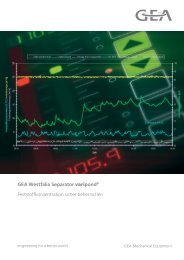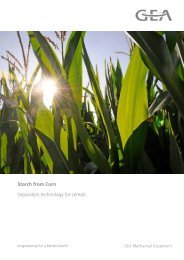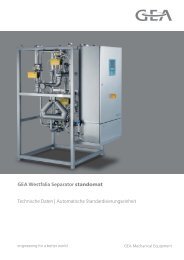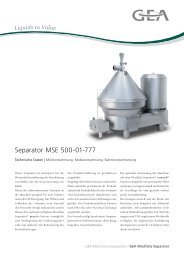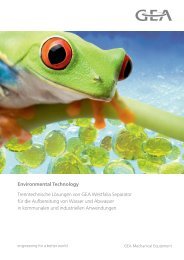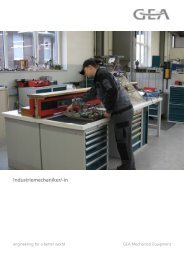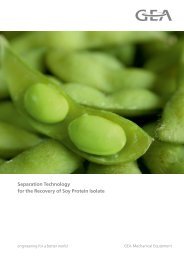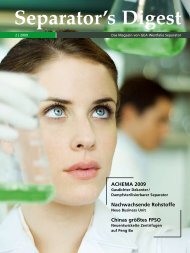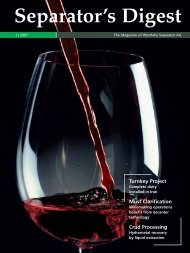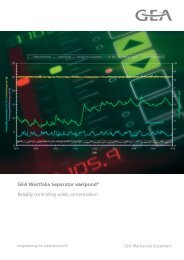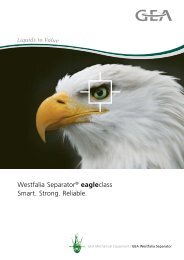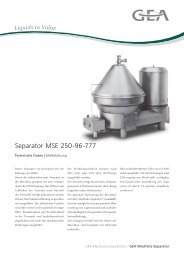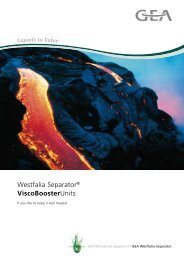Separator's Digest - GEA Westfalia Separator Group
Separator's Digest - GEA Westfalia Separator Group
Separator's Digest - GEA Westfalia Separator Group
You also want an ePaper? Increase the reach of your titles
YUMPU automatically turns print PDFs into web optimized ePapers that Google loves.
Central processing<br />
of raw milk<br />
Müllermilch decided to change over the<br />
operations with a daily milk processing<br />
quantity of approx. 400 t raw milk<br />
completely to the production of H-milk.<br />
because the plan involves the use of several<br />
UHt heating installations, the most costeffective<br />
solution for purifying and<br />
standardizing the milk was to use a cold<br />
milk skimmer including a standardizing<br />
system with sufficiently large capacity<br />
for central processing of the raw milk. In<br />
order to be able to produce skim milk<br />
with a minimum fat content, the plan was<br />
also for a milk pre-heater installation to<br />
be integrated, because the residual fat<br />
content in skim milk is very temperaturedependent.<br />
the order for a milk treatment installation<br />
with a cold milk separator type MSe 500<br />
with a capacity of max. 35,000 l / h raw milk<br />
and a Gea <strong>Westfalia</strong> <strong>Separator</strong> standomat<br />
MC for milk and cream standardization was<br />
placed by Müllermilch, following extensive<br />
preparations, with Gea <strong>Westfalia</strong> <strong>Separator</strong><br />
in oelde via the agent Gea <strong>Westfalia</strong><br />
<strong>Separator</strong> CZ s . r .o. because the intention<br />
was to minimise the installation and<br />
commissioning time, the focus was on<br />
complete pre-assembly in the oelde<br />
plant. tried-and-tested components from<br />
companies of the Gea <strong>Group</strong> were used<br />
almost exclusively for the design of the<br />
installation. accordingly, the pumps and<br />
valves come from Gea tuchenhagen, and<br />
the heat exchangers come from Gea<br />
ecoflex.<br />
Cold milk machine with<br />
a fully hermetic bowl<br />
the installation consists of a buffer tank<br />
with a regulated feed. the milk which<br />
comes from the raw milk tank is conveyed<br />
by the feed pump through a plate<br />
heat exchanger in which it can initially be<br />
pre-heated in a regenerative section and<br />
subsequently heated up to 15 °C in the<br />
heating section with warm water. the warm<br />
water is generated in a warm water circuit<br />
by means of steam. of course, it is also<br />
possible for the steam feed to be shut off<br />
entirely and for the milk to be processed<br />
cold.<br />
the milk is fed into the separator, where it<br />
is treated by means of centrifugal force and<br />
separated into skim milk and cream. the<br />
WeStFalIa <strong>Separator</strong> standomat MC aND MSe 500<br />
The milk treatment plant incorporates, among other things, an MSE 500<br />
cold milk separator and a <strong>Westfalia</strong> <strong>Separator</strong> standomat MC.<br />
MSe 500 cold milk machine is a version with<br />
a fully hermetic bowl. the slide-ring packings<br />
in the feed and discharge are cooled with<br />
water during the start-up and shut-down<br />
phases; this extends the service life of the<br />
packings. the density and temperature of<br />
the cream are measured in the Gea <strong>Westfalia</strong><br />
<strong>Separator</strong> standomat MC; these data are<br />
used to determine the fat content, and a<br />
hygienic regulating valve is used to set the<br />
desired concentration. a cream fat content<br />
of up to 42 percent is possible. the process<br />
control calculates the quantity of cream<br />
required to achieve the defined milk fat<br />
content. the excess cream is discharged via<br />
a further regulating valve, and is fed into a<br />
collecting tank; the remaining cream is<br />
recycled back into the skim milk.<br />
the excess cream is pumped from the<br />
collecting tank by means of a cream<br />
pump into the raw cream tank for<br />
further processing. the temperature of the<br />
standardised milk is lowered to less than<br />
4 °C in the regenerative and the ice-water<br />
cooling section of the plate heat exchanger.<br />
the milk is then fed into the finished milk<br />
tank, from where it is distributed to the UHt<br />
installations.<br />
Fully automatic cleaning<br />
During the production process, which can<br />
take 12 hours, fat may become deposited<br />
on the disks. this fat is removed from<br />
the separator by means of hot water<br />
intermediate flushing. For this purpose,<br />
product is displaced from the installation<br />
with water, and the buffer tank is filled with<br />
water. the temperature of the water in<br />
<strong>GEA</strong> <strong>Westfalia</strong> <strong>Separator</strong> Process 15<br />
<strong>Separator</strong>’s <strong>Digest</strong> 3 | 2008<br />
the circuit is raised to 60 °C; the design of<br />
the installation means that this process<br />
takes only a few minutes. the hot water<br />
circulates, and two partial ejections of the<br />
bowl are carried out in order to remove all<br />
remaining traces of fat. after this procedure<br />
has been completed, the contents of<br />
the installation are returned to production<br />
temperature with ice-water, and milk<br />
processing recommences. after the end of<br />
production, a completely automatic cleaning<br />
process is carried out by the central CIp<br />
station of the dairy.<br />
the entire installation is automated by<br />
means of a C 7 automation unit from<br />
Siemens with a local graphic display and<br />
a keyboard. the installation control is<br />
linked to the central control facility of the<br />
dairy via a profibus, and communicates all<br />
readings as well as valve and motor statuses<br />
to the central control facility. the command<br />
centre is responsible for operation and<br />
visualisation.<br />
the installation has been operating since<br />
the end of 2007; the technical acceptance<br />
procedure has already been completed, and<br />
the installation is operating to the complete<br />
satisfaction of the dairy.



